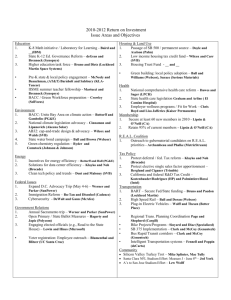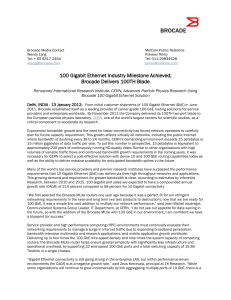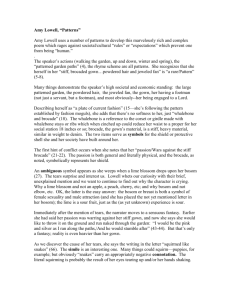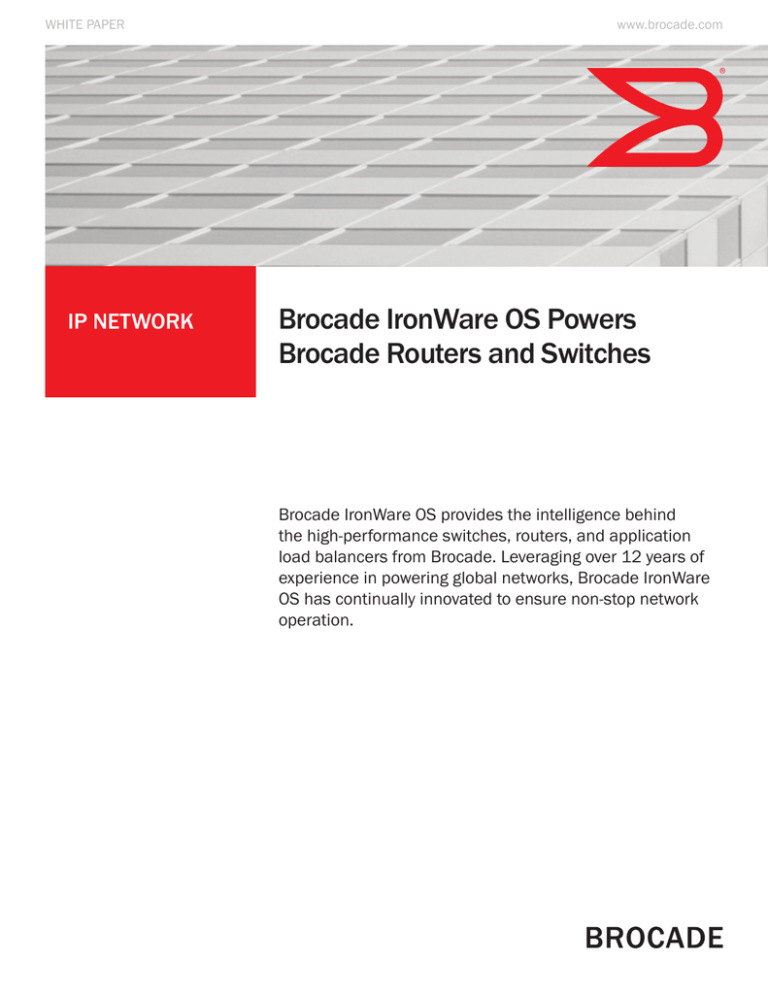
WHITE PAPER
IP Network
www.brocade.com
Brocade IronWare OS Powers
Brocade Routers and Switches
Brocade IronWare OS provides the intelligence behind
the high-performance switches, routers, and application
load balancers from Brocade. Leveraging over 12 years of
experience in powering global networks, Brocade IronWare
OS has continually innovated to ensure non-stop network
operation.
This white paper provides an overview of the high-level architecture of
the multi-service Brocade® IronWare® OS, which powers the Brocade
family of routers and switches. This operating system (OS) is designed
to efficiently address the diverse needs of today’s and tomorrow’s
infrastructures, while providing a flexible framework for powering
multiple Brocade platforms.
Note that the same operating system is leveraged across different
platforms and Brocade IronWare OS capabilities are fine tuned to
specific products. This paper also discusses advanced capabilities
such as high availability, modularity, fault tolerance, network
monitoring, security, and the role of Brocade IronWare OS in the
inevitable migration to IPv6.
Overview
The expanding role of IP networks in powering a variety of end-user applications in both
enterprise and service provider networks, makes network uptime and, by extension, uptime
of individual nodes extremely critical. Based on the experience of network administrators,
it’s clear that software plays a vital role in ensuring network uptime. Non-stop operation
capabilities in an operating system, act as insurance against the unexpected and ensure that
failures in a component of a node are quickly detected and addressed via a corrective action.
Brocade IronWare OS incorporates several capabilities that make it ideal for high
performance and high availability:
2
•
Distributed operating system with a very high level of distribution for maximum efficiency
•
Modular operating system that prevents corruption or interference of different modules
in Brocade IronWare OS
•
Multi-threaded operating system with different software modules running as light-weight
threads
•
Pre-emptive operating system for predictable performance by individual threads
•
High-availability capabilities to ensure non-stop operation of the system
•
Advanced protective checks in the operating system to ensure reliable operation of the
different software modules
Modular Architecture
The modular architecture of the Brocade IronWare OS incorporates a clear separation
between different modules and logical components in the operating system. For example,
an abstraction layer hides the underlying hardware layer from the upper layers, such as the
protocol layer. The underlying modular design of the OS greatly enhances the robustness of
the system and makes it easily portable to new platforms. For network operators, this gives
a common look and feel to all systems running Brocade IronWare OS, thereby decreasing the
operational costs of running a network.
Figure 1 shows the key components in Brocade IronWare OS.
System Management
Console, telnet, SSH, Web, SNMP, syslog
Common Management Interface
Unicast Routing Protocols
MPLS
L2 Control Protocols
DVMRP, PIM-DM, PIM-SM, BGP-MP
IP Stack
RSVP/TE, LDP
STP, 802.1w, MRP, VSRP
Figure 1.
Components in
Brocade IronWare OS.
Multicast Routing Protocols
RIP, OSPF, IS-IS, BGP
Routing Table Manager
VLAN Manager
Multicast Routing Table Manager
MAC Manager
HAL Mgmt. Module Redundancy Fabric & Chassis Mgmt. Card/Port Mgmt.
Kernel
Service and router
management
Management Module Hardware
IPC
Device/interface
management
IPC
HW Control
Forwarding
L2/L3/L4 Tables
SuperSpan
UDLD
sFlow
Agent
Kernel
Interface Module Hardware
The modular and distributed architecture is also reflected in the industry-leading rapid coldrestart time for routers and switches powered by this operating system. For example, highend, feature-rich systems such as Brocade BigIron® RX switches and Brocade MLX routers
have a cold restart time of less than 60 seconds from cold-start to service activation, even
after extensive diagnostic tests that are run during system bring-up.
Note that in Figure 1:
•
Distribution of Layer 2/3/4 forwarding tables to the interface module, which allows
packets to be forwarded by the hardware on the interface module without any processing
by software.
•
Distributed sFlow agent on every interface module which allows Brocade’s switches and
routers to provide very high-performance traffic monitoring even when sFlow is enabled
on all ports concurrently.
•
Uni-Directional Link Detection (UDLD) is performed completely on the interface module
for speedy detection of link failures and resulting corrective action.
SuperSpan is also performed by the interface module for scalable and high performance
tunneling of customer Spanning Tree BPDUs.
3
Clear Separation between Control and Data Planes
Brocade IronWare OS is architected with a clear separation between the control plane and
the data plane, which ensures a high-availability system at all times. Control messages
between the interface module and management module are sent on a separate out-of-band
redundant link, which is distinct from the path used for data traffic. Consequently, even
during times of very high utilization, control messages, which are crucial for correct system
operation, can still be exchanged reliably between the management and interface modules
without any loss.
Common Denial of Service (DoS) attacks in the network often target vulnerabilities in a
system when system utilization becomes high. A clear separation between control and data
planes greatly decreases the probability of a system being brought down by a DOS attack.
High Availability—Always
Brocade IronWare OS addresses high availability of a network from multiple angles:
•
Protection against faults within the system
•
Protection against faults within the network
Just as a chain is only as strong as its weakest link, a network should protect against faults in
the individual nodes as well as connectivity-related faults at the physical and higher network
layers.
The root cause for software faults in a system can often be traced to issues such as lost
control messages, buffer overflows, or poor congestion handling mechanisms in the
control plane. It is therefore extremely important for the underlying kernel to provide robust
mechanisms and take preventive measures against these conditions.
•
Protection against faults in the system is achieved with advanced protection capabilities
of the operating system’s robust kernel and fault-tolerant capabilities to ensure non-stop
operation in higher layer applications.
•
Protection against faults in the network is accomplished by incorporating redundant
links/paths in the network architecture with the use of appropriate protocols to detect
and handle network faults.
Each of these goals is accomplished using several mechanisms, described in the following
section.
Ironclad Protection in the Kernel
In order to ensure non-stop operation, the OS incorporates advanced protection and fairness
mechanisms. These underlying constructs ensure high availability of the system, predictable
and deterministic performance, and processing prioritization of high-impact events at peak
load, some of which are described below:
4
•
Enforcement of read/write rights by the kernel on shared data structures that are
accessed by multiple processes. With this capability, a process can register to access a
certain shared data structure with read-only or read-write privileges. Violations of these
access privileges can then be spotted immediately by the kernel.
•
Detection of memory violations by using separate virtual memory spaces. Key
components of the OS such as routing protocols have their databases in a secure
virtual memory space to prevent accidental corruption/access of those tables by errant
threads.
•
Detection of errant threads. The kernel watches for symptoms of errant threads.
Examples of monitored symptoms include spotting of stack usage violations, excessive
memory usage by a thread, or excessive CPU “hogging” by a single thread.
•
Multiple communication paths during Inter-Process Communication (IPC) with tiered
priority levels between the interacting threads.
•
Lightweight, reliable transport of IPC messages exchanged between processes on
different slots.
•
In distributed operating systems, it is imperative that the main table on the central
management module and the cached copy in the interface module remain in sync.
Brocade IronWare OS incorporates an integrity check mechanism wherein the data table
integrity is checked periodically between the module hosting the main copy (for example,
the management module) and the module hosting the cached copy (for example, the
interface module).
Fault-Tolerant Capabilities
Brocade IronWare OS includes several capabilities to enhance the tolerance to faults in both
the system as well as the network:
•
Hitless Layer 2 and 3 failover ensures that Layer 2 and 3 protocols running on the
primary management module smoothly fail over to the redundant management module
with virtually no negative impact on traffic forwarding or the routing/switching domain
throughout the network.
•
Graceful restart for BGP and OSPF allows a router to cooperate with its adjacent routers
in updating its own routing table (for example, after a management module failover)
without causing network-wide disruptions due to routing protocol re-convergence.
•
In-service OS upgrade allows new software patches or versions to be downloaded to the
system without any loss in traffic.
•
Switch fabric/fabric element/single lane failure detection in just a few milliseconds.
•
Removal of switch fabric module with no loss of traffic, a capability that is extremely
useful in planned network upgrades.
•
Rapid detection of ECMP failures, whether the constituent links are on the same
interface module or on different modules.
•
Rapid detection of trunk failures, whether the constituent links in the trunk group are on
the same interface module or on different modules.
•
Support for protocols such as VRRP/VRRP-E, RSTP, LACP (via IEEE 802.3ad), ECMP,
and BFD.
•
In Multiprotocol Label Switching (MPLS) networks, fast re-route and standby LSP
Paths are also invaluable in protecting against faults in the network. Brocade IronWare
provides both capabilities on MPLS-enabled platforms.
The ability to perform in-service upgrades is particularly critical in ensuring high availability.
Several studies have shown that planned upgrades of the network constitute a significant
portion of network downtime. On the other hand, the ability of downloadable modules,
wherein specific processes can be restarted, in-service upgrades with multiple management
modules allows for almost uninterrupted operation of the system during upgrades.
5
Security in Brocade IronWare OS
Brocade IronWare OS security features assist in guarding against malicious attacks, which
left unattended, could eventually lead to a compromised infrastructure. Support for Secure
Shell (SSH-v2) and Secure Copy (SCP) ensures that management traffic is encrypted.
Similarly, use of SNMPv3 and MD5 authentication in routing protocol exchanges ensures
that session or protocol exchanges are not exchanged in the clear. User authentication can
be performed using mechanisms such as RADIUS or TACACS+. 802.1x authentication is also
supported on switch ports with advanced features such as multiple 802.1x client support
(including limiting the number of clients that can be authenticated per interface) and MAC
port security.
The operating system allows configuration of the underlying hardware to detect and prevent
DoS attacks such as SYN attacks or Smurf attacks by monitoring interfaces for unusual
activity and setting thresholds for various traffic types. When a DoS attack is detected, the
port is automatically shut off by the OS and an operator alert is logged.
Brocade’s high-end platforms provide a large capacity for Access Control List (ACL) entries
that are distributed on each individual interface module, which is extremely valuable in
ensuring security of the network. In addition to the large numbers of hardware-based ACLs
on the platforms, the OS also has extensive support for ACL accounting and ACL logging. With
these capabilities, network administrators can track the number of hits to an ACL clause and
also log the information in an IP packet header when a hit is encountered. Such functions are
completely distributed to interface modules to increase efficiency.
In high-end platforms, a set of mechanisms called CPU protection is employed. These
mechanisms protect the Local Processor (LP) residing on the interface module, against
CPU hogging tasks. Under this framework, more functions that traditionally required
CPU processing are delegated to the hardware, such as broadcast/multicast/unknown
unicast flooding over VPLS. In addition, non-critical traffic requiring some LP processing for
completing a specific task, such as ACL logging or uRPF logging, is automatically throttled.
The amount of traffic going to the control plane is a common Trojan horse that is employed by
hackers to gain control of the system. Brocade IronWare OS allows ACL-based hardware traffic
policers to be applied to traffic going to CPUs within the system. Further, multiple priorities
are used by the OS to handle control traffic so that higher-priority control traffic is given
preferential treatment in the event of a congestion.
Brocade IronWare OS also has advanced capabilities that can be used to mitigate or prevent
malicious Man-in-Middle (MiM) attacks. These capabilities are implemented with support in
the underlying hardware to ensure high performance even when the security features are
enabled on the platform. Some of these advanced facilities are:
6
•
BPDU guard to prevent hijacking of networks running Spanning Tree Protocol (STP) by an
errant switch
•
Dynamic Address Resolution Protocol (ARP) inspection to detect malicious ARP packets
and false replies to ARP requests
•
IP source guard to prevent source IP address spoofing by malicious users; the OS
automatically installs an anti-spoof filter in the underlying platform hardware after
learning the IP address on a port.
•
With Dynamic Host Configuration Protocol (DHCP) snooping to automatically inspect
DHCP packets and learn and maintain IP address-to-MAC address bindings.
•
DHCP option 82 (relay agent) functionality to ensure that DHCP requests from clients
across untrusted ports are forwarded to the DHCP server after attaching information on
the circuit-id corresponding to the port.
Easing the Migration from IPv4to IPv6
As IP-based delivery of services continues its onward march, the demand for IP addresses will
continue to increase at a rate that will make migration to IPv6 imperative. Nevertheless, it is
essential for the transition to be seamless. Brocade IronWare OS offers two mechanisms to
facilitate this transition:
•
Dual-stack routing, in which routers run dual IPv4 and IPv6 stacks. In this scenario, the
backbone can be a dual-stack backbone with both the IPv4 and IPv6 routing protocols
and forwarding processes running in parallel. End systems can also run dual IPv4/v6
stacks in such a network.
•
IPv6 over IPv4 tunneling allows different IPv6 domains to communicate via an
intermediate IPv4 network. The OS supports the ability to create manually configured
tunnels, automatic IPv4-compatible IPv6 tunnels, and automatic IPV6-to-IPv4 tunnels.
Feature-Rich Brocade IronWare OS
Brocade IronWare OS supports a broad range of capabilities that makes it suitable for
mission-critical applications in both enterprise and service provider networks. The ability to
support multiple services on the same port simultaneously is one of its key attributes. The
OS offers extensive support for unicast IPv4 and IPv6 routing protocols, multicast protocols,
and great flexibility in configuring ACLs and traffic policers. On core router platforms such
as Brocade MLX routers, MPLS routing protocols such as RSVP, LDP, and advanced traffic
engineering capabilities permit the implementation of large-scale Layer 2 and 3 Virtual
Private Networks (VPNs). Advanced capabilities such as GRE tunnels and virtual routing
without MPLS provide additional choices to the network designer in designing a VPN.
For details on the feature set that is enabled on a platform, consult the data sheets on www.
brocade.com.
The Power of sFlow
sFlow, specified in RFC 3176, is a powerful network monitoring technology that can be
used for network anomaly detection, fault management, performance management,
service accounting, billing, and more. sFlow uses a statistical packet sampling approach to
accomplish its objectives and can be used to troubleshoot Layer 2 to Layer 4 flows in the
network. Brocade IronWare OSs distributed implementation of the sFlow agent on the target
platform allows real-time traffic monitoring on all ports without performance compromise. On
platforms that support L2 VPNs or L3 VPNs, such as Brocade NetIron® CER 2000 or Brocade
MLX Series, sFlow can also be used on VPN endpoints to provide valuable information on
VPN traffic.
Summary
Brocade IronWare OS is a feature-rich, multi-threaded, distributed operating system with
advanced capabilities to ensure secure, non-stop operation and high availability of the
network. The versatility of its design makes it an ideal operating system for powering many
of the routers and switches available today from Brocade.
About Brocade
Brocade provides innovative, end-to-end network solutions that help the world’s leading
organizations transition smoothly to a virtualized world where applications and information
can reside anywhere. These solutions deliver the unique capabilities for a more flexible IT
infrastructure with unmatched simplicity, non-stop networking, optimized applications, and
investment protection. As a result, organizations in a wide range of industries can achieve
their most critical business objectives with greater simplicity and a faster return
on investment.
For more information about Brocade products and solutions, visit www.brocade.com.
7
www.brocade.com
WHITE PAPER
Corporate Headquarters
San Jose, CA USA
T: +1-408-333-8000
info@brocade.com
European Headquarters
Geneva, Switzerland
T: +41-22-799-56-40
emea-info@brocade.co
Asia Pacific Headquarters
Singapore
T: +65-6538-4700
apac-info@brocade.com
© 2010 Brocade Communications Systems, Inc. All Rights Reserved. 09/10 GA-WP-1520-00
Brocade, the B-wing symbol, BigIron, DCFM, DCX, Fabric OS, FastIron, IronView, NetIron, SAN Health, ServerIron,
TurboIron, and Wingspan are registered trademarks, and Brocade Assurance, Brocade NET Health, Brocade One,
Extraordinary Networks, MyBrocade, and VCS are trademarks of Brocade Communications Systems, Inc., in the United
States and/or in other countries. Other brands, products, or service names mentioned are or may be trademarks or
service marks of their respective owners.
Notice: This document is for informational purposes only and does not set forth any warranty, expressed or implied,
concerning any equipment, equipment feature, or service offered or to be offered by Brocade. Brocade reserves the
right to make changes to this document at any time, without notice, and assumes no responsibility for its use. This
informational document describes features that may not be currently available. Contact a Brocade sales office for
information on feature and product availability. Export of technical data contained in this document may require an
export license from the United States government.


